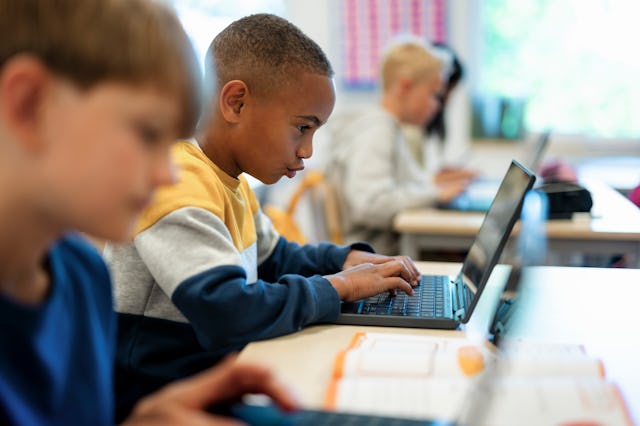Are Chromebooks Ruining Education? Teachers Are Tired Of Competing With Them, A Survey Found
What was wrong with pen and paper again?

Ahhh, screen time — it’s the debate that never stops online and in our own homes. The average American child between the ages of 8 and 18 spends roughly seven and a half hours on screens per day, according to the American Academy of Child & Adolescent Psychiatry. That number seems astronomical, but if your kid uses a laptop or tablet at school, it’s a lot easier to imagine how the hours add up. And for one teacher on TikTok, those school-issued devices are the reason education in America feels so dismal right now.
“It’s the Chromebooks. The Chromebooks ruined education. The iPads in every class ruined education. The fact that we have to put every single thing and make every lesson technology ruined education,” says teacher @__samanthajo on TikTok. “I’m already fighting how entertained they always are at home. Now I have to fight that they always have a Chromebook at their fingertips. I do everything that I can to get them off of it. I like hands-on learning, but they’re provided the Chromebook; we’re expected to teach with it. All we do all day is stare at screens, and then we wonder, ‘Why won’t they pick up a book? My kids don’t read. My kids can’t write a sentence.’ It’s because all we do is throw stimulation at them.”
She says we need to take Chromebooks out of schools and bring back workbooks, coloring sheets, pens, and paper — and the commenters agree. (Chromebooks are the most common school-issued tech in America, but one can assume her message applies to other laptops and tablets, too.) The top comment on the video? “BRING BACK COMPUTER LABS!!! There’s a time and place for screens!” “My kids get MAD when I make them write by hand. I’m not even joking,” said another. “We ban the phones, but the Chromebooks are fine????? It’s a no for me,” wrote one user.
A recent piece from The New York Times posed the same question: If phones are banned in schools, why are those same schools giving them tablets and laptops to do the bulk of their coursework and standardized testing? The reporters surveyed 350 pre-K through 12th-grade teachers from around the country and found that:
- 99% percent of respondents said their school provides devices to students for use in class, with 81% of elementary teachers saying students at their schools receive devices for use in class by kindergarten
- Three-fourths of teachers who use devices in their classrooms said they “distract from student learning and engagement in class, and a majority said children in their classrooms had used them to play games or watch videos unrelated to school.”
The Times also polled teachers about how much time the average student spends on screens at school, with the elementary estimate landing around an hour or less per day. In middle and high school, a little less than half of the teachers said that number jumps to three hours or more. As a result, they have seen handwriting skills plummet (spelling too), and overall “less stamina to focus on arduous tasks” that aren’t gamifying their lessons into an app.
The AACAP says too much screen time per day can lead to sleep problems, lower grades, less time spent reading and learning, and more — and they also note that it exposes children to potentially dangerous and misleading content. Here’s how much screentime they recommend by age:
- 18 months and younger: Use screen time only for video chatting (alongside an adult) with family and loved ones
- 18 to 24 months old: Limit screen time to watching educational programming with an adult present.
- 2 to 5 years: 1 hour per weekday and 3 hours on the weekend days.
- 6 years and older: Generally limit activities that involve screens, turning them off during family meals and outings. Use parental controls and avoid using screens to pacify children and avoid tantrums. Take all screens away or turn them off 30 to 60 minutes before bedtime. Encourage healthy habits and limit activities that include screens.
Every family’s stance on screen time is different, but it seems the majority of teachers wish there was a lot less of it in their classrooms.